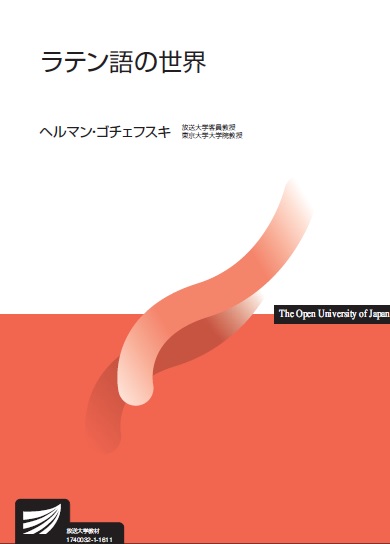
Title
Latin go no Sekai (The World of Latin)
Size
292 pages, A5 format
Language
Japanese
Released
March, 2016
ISBN
978-4-595-31609-8
Published by
Foundation for the Promotion of The Open University of Japan
Book Info
See Book Availability at Library
Japanese Page
This textbook was written as not only an accompanying material to a radio course (15 units) at the Open University of Japan but also an independent piece to be read as a monograph about Latin language and culture. As this is the first time the Open University has offered a course in Latin, the main aims of this book are to describe the peculiarities of Latin as a language compared to other (mainly Western) languages and provide an overview of the Latin alphabet, pronunciation, grammar, and literature. An overview of the history and cultural significance of the Latin language is also given.
Given these aims, this book does not almost contain any new research by the author; rather, it is based on the author’s teaching experiences, and surveys Latin from the Modern Language studies viewpoint. Therefore, the format is significantly different from usual language textbooks primarily because the author wrote this book as a guide to “learning about the Latin language” rather than as a study resource of Latin. Because of this focus, this book is designed for Latin language beginners who want to either gain some basic background information on the language or lay the foundation for their future Latin studies. However, it is also suitable for advanced students who wish to refresh and deepen their Latin knowledge to understand the broader cultural and systematic contexts more fully.
The Latin language, of course, uses “Roman letters.” The name “Latin” tells us that the Roman alphabet, which is widely used today in many languages around the world, originated from a Latin language culture. Further, the numerous variants in single letters and fonts as well as the deviating pronunciation in modern languages were also derived partly from Latin speech and writing. In other words, studying the history of Latin literacy and pronunciation provides a firm basis for understanding other literate cultures in Europe and beyond. Bearing this in mind, therefore, “The World of Latin” focuses more on Roman letter development and pronunciation than other Latin textbooks.
The major part of the book discusses the structure of Latin grammar. Compared to modern languages, such as Italian, French, German, or English, in Latin, the declension of the nouns, adjectives, and pronouns as well as the verb inflections is rather complicated and is often claimed to be more “logical” than intuitive (a view which is only partly shared by the author). However, understanding these aspects of Latin can provide a deeper understanding of other related Western languages. As the intention of the “The World of Latin” is to provide an overview to the acquisition of Latin language skills, the subject order is somewhat different from usual textbooks, allowing readers to understand the main characteristics of the Latin language in a short time.
Apart from these two focuses, a brief survey of the main Latin literature genres is given. In addition, the structure and form of classical Latin poems, all of which were derived from ancient Greek poetry and their declamation, is covered in a special chapter.
(Written by Hermann Gottschewski, Professor, Graduate School of Arts and Sciences / 2017)



 Find a book
Find a book


